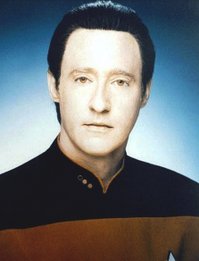The USS Enterprise is close to crunching the flying saucer from The Day the Earth Stood Still, which brushes near Star Wars' Millennium Falcon.
"Look," Donna Shirley says as another craft floats in from galactic sector 17. "The mother ship from Close Encounters of the Third Kind."
It's interstellar gridlock here at Seattle's Science Fiction Museum and Hall of Fame.
Opened earlier this summer, SFM is the world's only major science fiction museum, a multimillion-dollar, multimedia extravaganza launched by Microsoft cofounder and sci-fi buff Paul Allen. Its location is suitably future-minded: along-side that icon of New Frontier optimism, the Space Needle, and smack inside the Frank O. Gehry-designed structure that also houses the Experience Music Project, a building that resembles one of those silicon-based life-forms that devoured hapless yeomen on the original Star Trek.
[ILLUSTRATION OMITTED]
Given that SFM celebrates two centuries of sci-fi, from Frankenstein to Futurama, visiting it is understandably a little overwhelming. The moment you step inside, you're bombarded by Jules Verne, H.G. Wells, Robbie the Robot, "Danger, Will Robinson," "Gort, Klaatu barada nikto," bathing-suited babes imperiled by "Tetrahedra of Space," and the earth, the moon, the stars.
It is, in short, like having the universe poured into your brain. Or like being poured into the brain of a sci-fi-crazed 12-year-old boy, an analogy I make with some assurance, having once been that boy. "We wanted to create a place that told the truth about science fiction," says science fiction and fantasy novelist Greg Bear, chair of the museum's advisory board. "A place that described all its aspects, the paranoia, the wonderment."
On my visit, I am shown around by the museum's director, Donna Shirley. We start off by admiring a prize piece from Paul Allen's personal collection: the original commander's chair from the bridge of the USS Enterprise. Astonishingly, Captain Kirk was able to defeat Klingons sitting in a '60s-style office chair using petrified Jujubes as controls. From here Shirley leads me through the rest of the museum, a sci-fi fan's heaven of film clips and robots and ray guns, ending with the giant insect queen that menaced Sigourney Weaver in Aliens. "I never saw that," Shirley confesses. "I don't like scary movies."
Shirley, in fact, views sci-fi from the levelheaded perspective of someone who has made hard science her life: As an engineer at NASA's Jet Propulsion Laboratory, she led the Mars Exploration Program and helped send Mars Sojourner to the surface of the red planet. She credits childhood reading of Arthur C. Clarke and Isaac Asimov for starting her on her career. "If you talk to people in the space biz," she says, "you'll find that most of them grew up with science fiction."
Understandably, she takes a proprietary pride in the exhibits devoted to Mars, which of all heavenly bodies has inspired humankind's most fevered leaps of imagination. Here are the panic-inducing creatures from War of the Worlds and the sweet, smiling My Favorite Martian. One poster advertises my own worst nightmare: 1953's Invaders from Mars, a movie I watched on TV at age 10 and have not yet recovered from. ("NOT SUITABLE FOR CHILDREN," the movie poster advises. "Now they tell me," I think.)
Inevitably, Shirley says, as science learns more about the actual universe, science fiction's musings prove inaccurate, incomplete. But science then presents science fiction new data with which to spin new dreams. "Science fiction is about 'What if?' 'What if your best friend were an android?' 'What if you could clone yourself?'" Shirley says. "There's a lot of schlocky science fiction. But real science fiction makes you think."
We head back to the simulated space station, where we watch science fiction's most famous spaceships attempt to dock. There's Han Solo's Millennium Falcon; there's the Alien-ridden Nostromo. There's the wonderment and the paranoia, the worst you can imagine and the best, and beyond them a twinkling universe of infinite fascination.
INFO: Science Fiction Museum and Hall of Fame ($13; 10-8 daily; 325 5th Ave. N., Seattle; www.sfhomeworld.org or 877/724-3428)
COPYRIGHT 2004 Sunset Publishing Corp.
COPYRIGHT 2004 Gale Group



